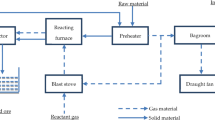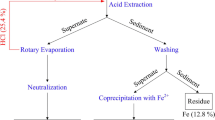Abstract
Magnetite (Fe3O4) ore is concentrated by low-magnetic-field drums to recover a magnetite concentrate that is low in silica (SiO2). The presence of SiO2 in the magnetite concentrate for steel production increases the steel processing costs, so a major challenge in magnetic concentration is to lower the SiO2 grade in the Fe concentrate. This work presents studies that were carried out on the removal of SiO2 from the magnetite concentration at the plant scale. Studies were performed with a three 36 × 96″ drum unit processing 46 ton/h of rougher magnetite concentrate. These studies showed that silica appears in the magnetite concentrate by three mechanisms, namely SiO2 entrainment in Fe3O4 chains, heterocoagulation between Fe3O4 and SiO2 particles, and mineral locking of SiO2 to Fe3O4. The SiO2 entrainment mechanism had the highest contribution (75%) to the SiO2 recovered in the Fe concentrate. Electrokinetic studies on Fe3O4 and SiO2 showed that heterocoagulation occurs because of the low negative zeta potential of the minerals at the pH of the plant slurry. This study also showed that a high percentage of ultrafine size SiO2 particles trapped in Fe3O4 agglomerates was not removed by the dilution water for the slurry fed to the drum. To lower the SiO2 recovery in the drum magnetic concentration process, work should be directed towards the removal of trapped SiO2 in Fe3O4 agglomerates.













Similar content being viewed by others
References
Wills BA, Napier-Munn TJ (2006) Wills’ mineral processing technology: an introduction to the practical aspects of ore treatment. Butterworth-Heinemann, Oxford
Yarar B, Dogan ZM (1987) Mineral processing design. Martinus Nijhoff Publishers, Boston
Parker MR (1977) The physics of magnetic separation. Contemp Phys 18(3):279–306
Svoboda J (2004) Magnetic techniques for the treatment of materials. Kluwer Academic Publisher, The Netherlands
Sylvester PJ (2012) Use of mineral liberation analyzer (MLA) for mineralogical studies of sediments and sedimentary rocks, Mineralogical Association of Canada Short Course 42
Hogg R, Healy TW, Fuerstenau DW (1966) Mutual coagulation of colloidal dispersions. Trans Faraday Soc 62:1638
Israelachvili JN (2011) Intermolecular and surface forces. Academic Press, Cambridge
García-Martínez HA, Llamas-Bueno M, Song S, López-Valdivieso A (2004) Magnetic flocculation of mineral fines in an external magnetic field. Miner Process Extr Metall Rev 25:67–90
Garcia-Martinez HA, Song S, Lopez-Valdivieso A (2011) In situ observation of quartz particles entrained into magnetite coagulates in a uniform magnetic field. Miner Eng 24:963–966
López-Valdivieso A, Corona-Arroyo MA, Encinas-Oropesa A, García Martínez HA, Aquino- Rosalío CE, Nahmad-Molinari Y (2018) Inhibiting the amine flotation of magnetite through aggregation with uniform low magnetic fields and no chemical depressants. Miner Eng 119:130–136
Llamas-Bueno M (2010) Removal of SiO2 in magnetite concentration by applying external forces in the low-magnetic concentration process (in Spanish), Ph. D. Thesis in Minerals Engineering, Universidad Autonoma de San Luis Potosi, 112 p
Acknowledgements
The authors would like to thank the National Council for Science and Technology, México (CONACyT) for the Ph. D. Fellowship 170585 in Minerals Engineering to Mario Llamas-Bueno and the Ph. D. Fellowships 230133 in Materials Science and Engineering to Mario A. Corona-Arroyo, Autonomous University of San Luis Potosi (UASLP), México.
Author information
Authors and Affiliations
Corresponding author
Ethics declarations
Conflict of interest
The authors declare that they have no conflict of interest.
Rights and permissions
About this article
Cite this article
Llamas-Bueno, M., López-Valdivieso, A. & Corona-Arroyo, M.A. On the Mechanisms of Silica (SiO2) Recovery in Magnetite Ore Low-Magnetic-Drum Concentration. Mining, Metallurgy & Exploration 36, 131–138 (2019). https://doi.org/10.1007/s42461-018-0019-5
Received:
Accepted:
Published:
Issue Date:
DOI: https://doi.org/10.1007/s42461-018-0019-5




